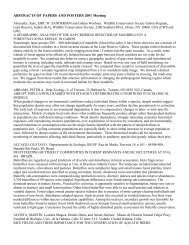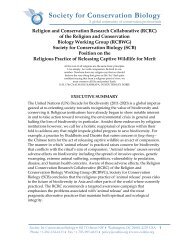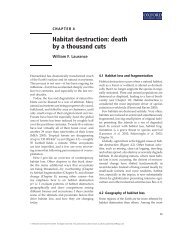Endangered species management: the US experience - Society for ...
Endangered species management: the US experience - Society for ...
Endangered species management: the US experience - Society for ...
You also want an ePaper? Increase the reach of your titles
YUMPU automatically turns print PDFs into web optimized ePapers that Google loves.
Sodhi and Ehrlich: Conservation Biology <strong>for</strong> All. http://ukcatalogue.oup.com/product/9780199554249.do<br />
226 CONSERVATION BIOLOGY FOR ALL<br />
habitat, population size, trends in population<br />
size, or trends in <strong>the</strong> amount of habitat (www.<br />
iucnredlist.org/static/categories_crtiteria). The<br />
original Red List categories and criteria were designed<br />
to determine <strong>the</strong> global status of <strong>species</strong>,<br />
but conservation biologists subsequently have<br />
developed guidelines <strong>for</strong> applying those criteria<br />
to individual nations, states, provinces, etc.<br />
The ESA, however, is notably vague in defining<br />
what constitutes a <strong>species</strong> at risk of extinction.<br />
It establishes two categories of risk, endangered<br />
and threatened, and defines an endangered <strong>species</strong><br />
as “any <strong>species</strong> which is in danger of extinction<br />
throughout all or a significant portion of its<br />
range” and a threatened <strong>species</strong> as “any <strong>species</strong><br />
which is likely to become an endangered <strong>species</strong><br />
within <strong>the</strong> <strong>for</strong>eseeable future throughout all or a<br />
significant portion of its range” (<strong>Endangered</strong> Species<br />
Act, Sections 3(6) and 3(19)). In practice, most<br />
plants and animals have not been added to <strong>the</strong><br />
<strong>US</strong> endangered <strong>species</strong> list until <strong>the</strong>y were close<br />
to extinction. A study published in 1993 (Wilcove<br />
et al. 1993) showed that <strong>the</strong> median total population<br />
size of a vertebrate at time of listing was 1075<br />
individuals; <strong>the</strong> median number of surviving populations<br />
was two. For invertebrate animals, <strong>the</strong><br />
median total population size was less than 1000<br />
individuals, and <strong>the</strong> number of surviving populations<br />
was three. In <strong>the</strong> case of plants, <strong>the</strong> median<br />
total population size was less than 120<br />
individuals, and <strong>the</strong> number of surviving populations<br />
was four. One obvious consequence of<br />
waiting until <strong>species</strong> are so rare be<strong>for</strong>e protecting<br />
<strong>the</strong>m is that recovery becomes far more difficult,<br />
if not impossible, to achieve.<br />
12.2 Protection<br />
In order to develop an effective protection plan<br />
<strong>for</strong> endangered <strong>species</strong>, one needs to know a<br />
minimum of two things: (i) What threats do <strong>the</strong><br />
<strong>species</strong> in question face; and (ii) Where do those<br />
<strong>species</strong> occur Knowledge of <strong>the</strong> threats will determine<br />
protection and recovery ef<strong>for</strong>ts, while<br />
knowledge of <strong>the</strong> location and, in particular, <strong>the</strong><br />
land ownership, will guide <strong>the</strong> choice of conservation<br />
strategy.<br />
12.2.1 What are <strong>the</strong> threats<br />
Understanding <strong>the</strong> threats facing endangered<br />
<strong>species</strong> is complicated due to four factors:<br />
(i) threats may vary from taxon to taxon; <strong>the</strong> things<br />
that imperil freshwater fish, <strong>for</strong> example, may not<br />
necessarily be <strong>the</strong> things that imperil terrestrial<br />
mammals; (ii) threats may vary geographically,<br />
depending on economics, technology, human demography,<br />
land-use patterns and social customs<br />
in different areas; (iii) threats may change over<br />
time, again in response to technological, economic,<br />
social, or demographic factors; and (iv) <strong>for</strong> all but a<br />
handful of groups (e.g. birds, mammals, amphibians),<br />
scientists simply do not know enough<br />
about most <strong>species</strong> to determine which ones are<br />
imperiled and why <strong>the</strong>y are imperiled.<br />
For three groups—birds, mammals, and amphibians—<strong>the</strong><br />
IUCN has determined <strong>the</strong> conservation<br />
status of virtually all extant and recently<br />
extinct <strong>species</strong> (Baillie et al. 2004). These data<br />
provide <strong>the</strong> best global overview of threats to<br />
endangered <strong>species</strong> (Figure 12.1). With respect<br />
to birds and amphibians, habitat destruction is<br />
by far <strong>the</strong> most pervasive threat: over 86% of<br />
birds and 88% of amphibians classified by IUCN<br />
as globally imperiled are threatened to some degree<br />
by habitat destruction. Agriculture and logging<br />
are <strong>the</strong> most widespread <strong>for</strong>ms of habitat<br />
destruction (see Chapter 4). Overexploitation<br />
<strong>for</strong> subsistence or commerce contributed to <strong>the</strong><br />
endangerment of 30% of imperiled birds but only<br />
6% of amphibians (see Chapter 6). Alien <strong>species</strong><br />
were a factor in <strong>the</strong> decline of 30% of imperiled<br />
birds and 11% of amphibians (see Chapter 7).<br />
Pollution affected 12% of imperiled birds and<br />
4% of amphibians (see Box 13.1). Disease, which<br />
is often linked to pollution or habitat destruction,<br />
was a threat to 5% of birds and 17% of amphibians.<br />
Surprisingly, few <strong>species</strong> were identified as<br />
being threatened by human-caused climate<br />
change, perhaps because most threats are identified<br />
after <strong>the</strong> fact (see Chapter 8). However,<br />
Thomas et al. (2004) modeled <strong>the</strong> response of<br />
localized <strong>species</strong> of various taxa to climate<br />
change and concluded that 15–37% of <strong>the</strong>m<br />
could be destined <strong>for</strong> extinction by 2050, making<br />
climate change potentially a grave threat.<br />
© Ox<strong>for</strong>d University Press 2010. All rights reserved. For permissions please email: academic.permissions@oup.com






